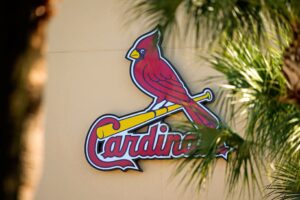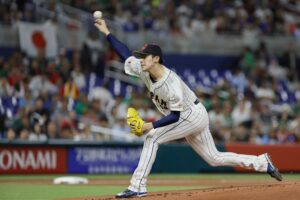Joe Ross 2021 Season Preview
Joe Ross has had one of the more fascinating career trajectories in the Washington Nationals organization. Coming to Washington in a three-team trade, Ross was a consensus Top 100 prospect prior to his MLB debut. In his first two seasons in the majors, Ross not only impressed the Nationals, but also the rest of baseball. There were reports that the New York Yankees were targeting Ross as a centerpiece of an Aroldis Chapman trade, a piece that ended up being Gleyber Torres.
Ross pitched in 35 games in his first two seasons, posting a 3.52 ERA and striking out eight batters per nine innings. However, he did not look the same the next season. His sinker dipped 1.9 miles per hour in 2017, down to 91.5 miles per hour. Finally, Ross underwent Tommy John surgery in 2017, after struggling and posting a 5.01 ERA.
Once Ross made a brief return in 2018, his repertoire seemed to be starkly different from years before. He relied on a straight four-seam fastball, rather than his ground ball pitch: the sinker. His struggles continued into 2019, but Ross seemed to make strides, following his August 2nd start in Arizona. He finished the season 4-1 with a 2.75 ERA in his last 8 starts. To cap off his season, he had a heroic start in place of Max Scherzer in the World Series.
In 2020, Ross opted out of the season due to Covid-19 concerns. Now, heading into 2021, the Washington Nationals need Ross to hold down the fifth starter spot and maybe get back onto his pre-Tommy John trajectory.
Consistent Fastball Command
Since returning from Tommy John, Ross has yet to show the same command he displayed in his first three seasons. From 2015-2017, Ross walked just 2.5 batters per nine innings and posted a 3.29 strikeout to walk ratio. However, in his last two seasons, Ross has averaged 4.2 walks per nine innings and a subpar 1.73 strikeout to walk ratio. Even in starts where Ross pitched well, his command was still an issue. In his 5.1 no-hit innings against the Arizona Diamondbacks, Ross walked five batters, causing him to be pulled in the sixth. These high pitch counts that come as a result of walks are a key reason why Ross struggled to go deep into games in 2019.
Ross’s best pitch is most likely his slider which has legitimate “swing and miss” potential. However, his slider will only be effective if he commands his sinker low in the zone. By establishing the sinker at the knees, it will be easier to deceive hitters into swinging at sliders in the dirt.
Pitching to Strengths
One of the more mystifying points in Ross’s career was his incorporation of a four-seam fastball into his repertoire. Last season, he threw 283 four-seam fastballs, despite not throwing more than 42 before Tommy John. Hitters slugged .512 on his four-seam compared to just .404 on his sinker. A key correlation to this is his dramatic decrease in ground ball to flyball ratio. After posting GB/FB ratios of 2.56 and 2.51 in his first two seasons, he had ratios of 1.43 and 1.87 in his last two seasons. Part of this is attributed to the rust after surgery, but Ross must pitch to his strengths: being a ground ball pitcher. Last season, when Ross had at least six ground ball outs, he went 4-0, allowing two or fewer runs in each of his six starts, including three starts where he did not allow a single earned run.
Another key for Ross is to effectively use his slider and curveball. Ross added in a more “12 to 6” curveball last season, which is just a variant of his slider. This pitch had a 41.7% whiff percentage. His normal slider, which averaged 88 miles per hour, had a 30.7 whiff percentage. In his first three seasons, his slider was at least 36.7% in that department. Finally, in his rookie season, hitters batted a minuscule .136 on his slider, while batting .279 in 2019 (not including his curveball). Having a consistent putaway pitch would do wonders for Ross heading into 2021.
The Elusive Changeup
While Ross has added a third pitch, his changeup has yet to come around. As a prospect, Ross was thought of as a two-pitch pitcher, with his sinker and slider combination. In 2015, Ross threw just 70 changeups as hitters batted .478 on it. It improved as he went on in his MLB career, since opposing batting averages dropped to .279 and .259 the following seasons, against his changeup. However, this number ballooned to .381 in 2019. This was noticeable in his splits, as left-handed batters hit .314 as a whole against Ross, while right-handed batters hit just .272. An even larger discrepancy can be seen for Ross throughout his career. Right-handed hitters have batted .239 against Ross, while left-handed hitters have hit .303.
Employing a solid changeup that could keep left-handed hitters honest would close the gap between these splits for Ross in 2021.
A “Young” Starter in an Aging Rotation
If he wins the fifth starter competition, then Joe Ross will play a massive role in the Washington Nationals rotation moving forward. While Washington is built upon its three premier starters, Stephen Strasburg is coming off carpal tunnel neuritis and Patrick Corbin had a 4.66 ERA last season, while allowing an NL-leading 85 hits. Max Scherzer will also turn 37 in July. Despite having a surplus of pitching on its top ten prospect lists, the Nationals’ farm system is considered one of the worst in the majors. Due to that, the 27-year old starter Joe Ross could be a vital piece moving forward.
Main Image:
Embed from Getty Images
Players Mentioned: Joe Ross, Aroldis Chapman, Gleyber Torres, Max Scherzer, Stephen Strasburg, Patrick Corbin.






